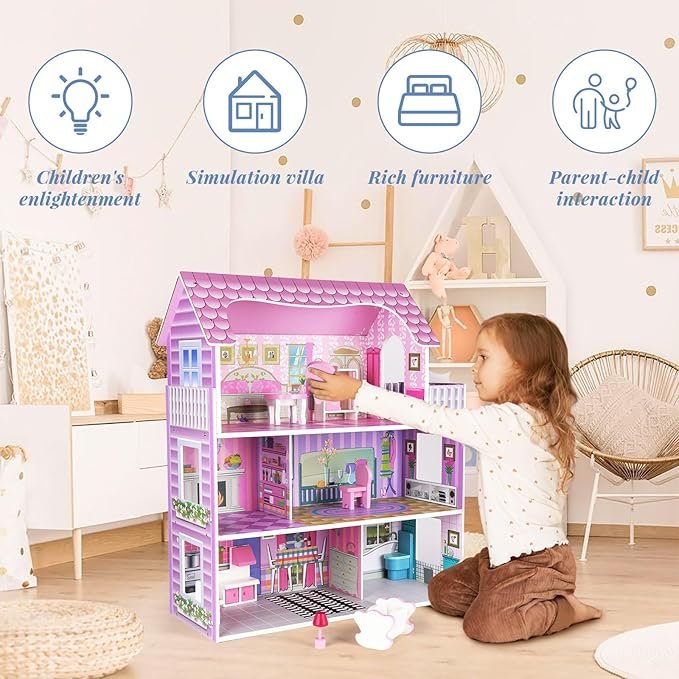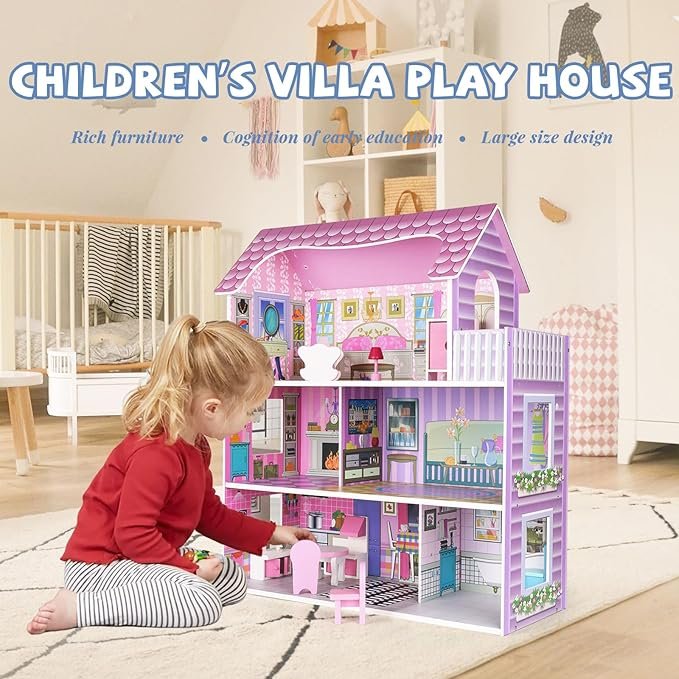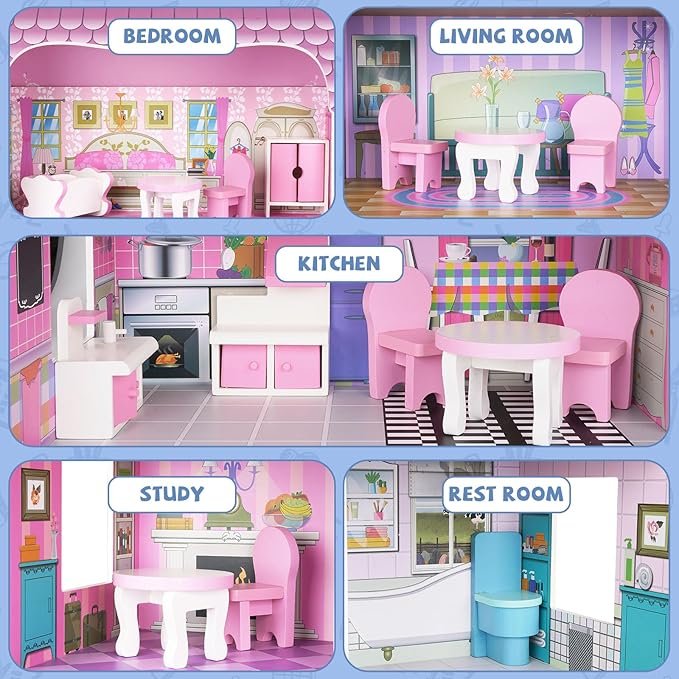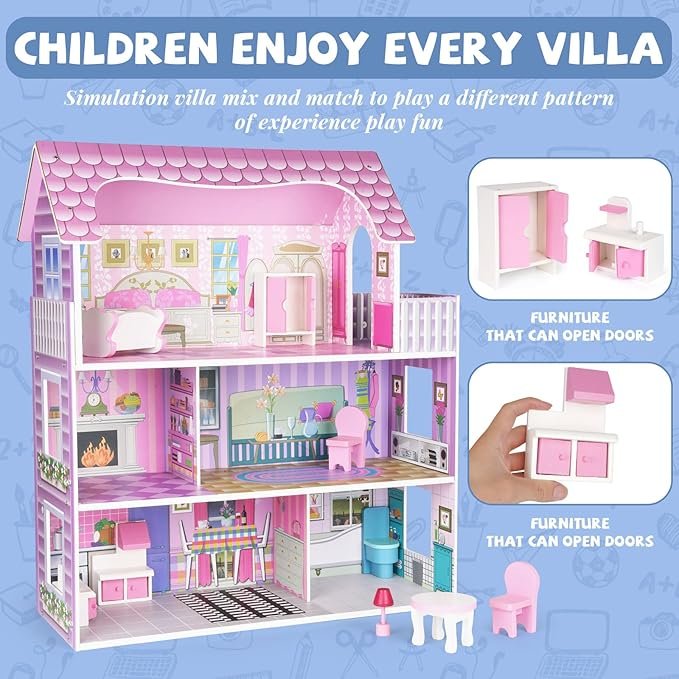Wooden Dollhouses
Wooden Dollhouses for Girls: The Timeless Appeal of Classic Playtime
When it comes to imaginative play, few toys are as iconic and enduring as the dollhouse. For generations, dollhouses have provided a space for children to engage in storytelling, creativity, and role-play, offering endless hours of fun. Among the various types of dollhouses available, wooden dollhouses stand out for their durability, aesthetic appeal, and their ability to offer a more tactile, immersive experience for young children. In this article, we will explore why wooden dollhouses remain such a popular choice for girls, the benefits they offer, how to choose the right one, and the best ways to incorporate them into play.

Wooden Dollhouse for Girls, 3-Story Doll House Playset with Furniture & Accessories, Large DIY Wooden Dream House for Kids, Pretend Play Dollhouse Kit, for Toddlers & Girls
Introduction: The Enduring Appeal of Wooden Dollhouses
Dollhouses are more than just toys; they serve as miniature worlds where children can create their own stories, design spaces, and even replicate the world they live in. For many parents and caregivers, the decision to invest in a dollhouse is also a decision to provide children with a tool that promotes learning and developmental growth. Among the wide variety of dollhouses on the market today, wooden dollhouses have a unique charm that distinguishes them from their plastic counterparts.
Table of Contents
Wooden dollhouses have been beloved for decades and continue to captivate young minds because they encourage hands-on interaction, offer lasting quality, and spark creativity in a way that appeals to children of all ages. For young girls, especially, these dollhouses offer not only a fun activity but also opportunities for problem-solving, storytelling, and even fine motor skills development.
1. The Benefits of Wooden Dollhouses for Girls

Promoting Imagination and Creativity
One of the key benefits of wooden dollhouses is the imaginative play they foster. A dollhouse serves as a blank canvas that children can fill with characters, settings, and scenarios limited only by their imagination. For girls, this becomes a personal space where they can explore different roles, relationships, and environments. Whether they are designing a cozy living room for a family of dolls or hosting a tea party, the dollhouse becomes an essential tool for developing creativity.
The tactile nature of wooden materials also allows children to interact with their toys in more meaningful ways. Wooden furniture and accessories are often crafted with intricate details, which inspires children to engage with them thoughtfully—arranging and rearranging objects to create new settings and stories.
Developing Fine Motor Skills

Playing with dollhouses involves fine motor skills, as children move and manipulate tiny furniture, place dolls in different positions, and move objects around within the space. These activities help strengthen hand-eye coordination and dexterity. Wooden dollhouses are often designed with larger pieces, making them easier for younger children to handle and arrange without frustration.

For girls, in particular, the act of organizing and decorating the dollhouse can improve their spatial awareness and help them learn concepts like balance, symmetry, and proportion. These skills are fundamental not only for play but also for later success in various academic and real-world applications.
Social and Emotional Development
Dollhouses offer more than just a chance for physical interaction with objects; they also provide an avenue for children to engage in social and emotional development. By pretending to interact with dolls or figurines, girls can practice empathy, problem-solving, and communication. They may create complex social narratives, where dolls have relationships, work together to solve problems, or navigate emotional challenges. These imaginary scenarios can help children process their feelings and gain a better understanding of how to relate to others.
As children play, they often assign roles to each doll, teaching them about diversity, cooperation, and conflict resolution. By navigating these stories, girls can also develop a sense of identity, as they see themselves reflected in the dolls and scenarios they create.
2. Key Features to Consider When Choosing a Wooden Dollhouse
With so many wooden dollhouses available on the market, it can be challenging for parents to know where to start. Here are several key features to consider when selecting the perfect dollhouse for a young girl:
Size and Scale

Wooden dollhouses come in a range of sizes, from small single-room models to large multi-story estates. It’s important to choose a size that fits the space where the dollhouse will be placed and that matches the child’s ability to play with it comfortably. A larger dollhouse allows for more elaborate play scenarios, but it may require more space and may be difficult to transport or store.
The scale of the dollhouse should also correspond to the size of the dolls that will be used. Many wooden dollhouses come with accompanying doll families that are sized to fit snugly within the rooms, while others are designed to allow for a variety of doll sizes. Ensure that the dollhouse and its accessories are compatible with the dolls that the child already has or plans to use.
Quality of Materials and Craftsmanship
Wooden dollhouses are known for their durability, which is one of their greatest selling points. Unlike plastic toys that can break or wear down over time, a well-crafted wooden dollhouse is built to last and can withstand years of active play. Look for dollhouses made from solid wood (such as pine or birch), which tend to be more durable than those made from particleboard or MDF (medium-density fiberboard).
The quality of craftsmanship also matters, as it affects how easily the dollhouse can be assembled and how enjoyable it is to use. Well-made dollhouses will have smooth, splinter-free surfaces, well-fitting doors and windows, and sturdy construction that can withstand frequent handling.
Design and Aesthetics
The design of the dollhouse is another important consideration. Many wooden dollhouses feature a classic or vintage style, with charming architectural details such as intricate moldings, shingled roofs, or decorative windows. For girls who enjoy role-playing and storytelling, the aesthetic appeal of the dollhouse can make a big difference in how immersed they feel in their play.
Some dollhouses allow for customization, with removable wallpaper or interchangeable accessories that let girls add their own personal touches. For example, girls can choose from a variety of miniature furniture sets, wall colors, and decorative accents that fit their style.
Safety Considerations
Since dollhouses are typically played with by young children, safety should always be a top priority. Ensure that the dollhouse is free from sharp edges, small removable parts that could be a choking hazard, and toxic paints or finishes. Many reputable manufacturers of wooden dollhouses use non-toxic, child-safe materials, which are an essential factor to look for when making a purchase.
3. How to Incorporate a Wooden Dollhouse into Play
Once you’ve selected the perfect wooden dollhouse, it’s time to encourage imaginative and educational play. Here are a few ways to make the most of this timeless toy:
Create Stories and Narratives
Encourage your child to create stories and scenarios for their dolls. This can involve simple everyday activities like cooking or cleaning, or more elaborate adventures, such as going on a trip or solving mysteries. By expanding their narrative play, girls can develop an understanding of how stories unfold, learn about cause and effect, and enhance their language skills as they narrate the adventures of their dolls.
Incorporate Learning Themes
Wooden dollhouses offer an opportunity to integrate educational themes into play. For example, you could encourage your child to explore the concept of family dynamics by assigning different roles to the dolls, or teach them about architecture and design by allowing them to furnish and decorate each room. Girls can also experiment with colors, shapes, and textures while decorating, offering a hands-on approach to learning about design principles.
Invite Collaborative Play
Dollhouses can also be a great way for children to engage in cooperative play with siblings, friends, or parents. Taking turns to create new stories or to add furniture and accessories to the house can foster collaboration and communication. Additionally, working together on decorating or arranging the dolls encourages the development of social skills like sharing, patience, and compromise.
Conclusion: The Timeless Value of Wooden Dollhouses
Wooden dollhouses offer much more than just a fun toy; they provide an enduring tool for learning, creativity, and social development. With their high-quality craftsmanship, engaging designs, and ability to inspire imaginative play, wooden dollhouses have earned their place as a classic item in many homes. For girls, these dollhouses offer an opportunity to explore different facets of life, design, and relationships in a safe and enjoyable way.
Whether you are looking to spark a love of storytelling, develop fine motor skills, or encourage collaborative play, a wooden dollhouse is a wonderful investment that can provide years of entertainment and educational benefits. As children grow and change, these dollhouses will continue to provide the foundation for new stories, new ideas, and new adventures. The combination of durability, versatility, and creativity ensures that wooden dollhouses remain a timeless choice for girls of all ages.